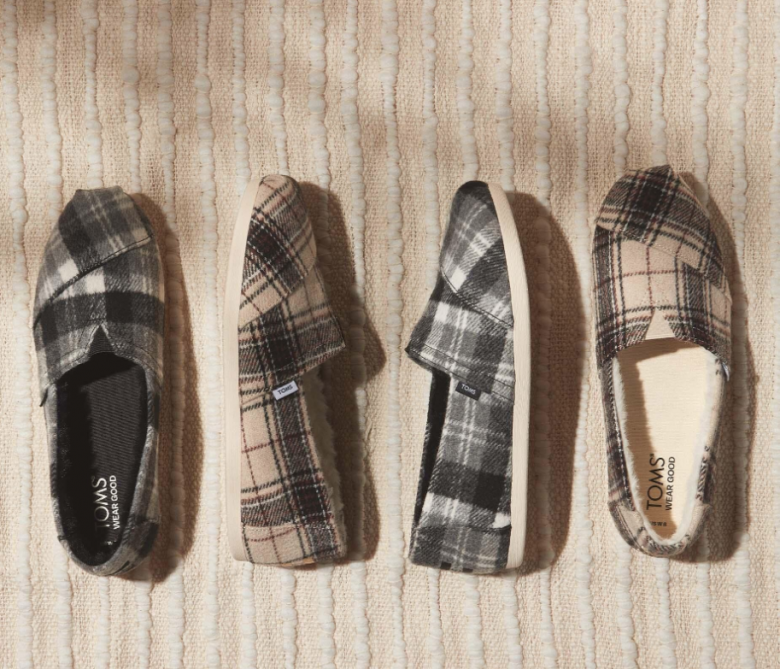Image credit: TOMS
When an entrepreneur combines their passion for business with a desire to give back to the world, great things can happen. Including the creation of a whole new type of business model.
If you’re an entrepreneur looking for a business model that not only is profitable but also allows you to give back to issues that you’re passionate about, the one-for-one business model may be perfect for you. In this article, we will define the one-for-one business model and take a look at some of its advantages and disadvantages.
What is the One-for-One Business Model?
The one-for-one business model is when a business pledges that for every item purchased that same item or a similar one will go to a person or community in need. Even if you’ve never heard of this specific business model you’re likely already very familiar with it. TOMS Shoes paved the way for the one-for-one business model.
Blake Mycoskie came up with the idea for TOMS Shoes after taking a trip to Argentina in 2006. There, he came across the traditional Argentine alpargata—a lightweight, casual shoe that locals wore. He also noticed the many children walking barefoot in rural and urban areas.
Mycoskie knew that the lack of shoes in these areas could lead to cuts, infections, and soil-transmitted diseases. Also, in many schools, shoes are a mandatory part of the uniform. Without them, children are barred from receiving an education. This further perpetuates the cycle of poverty.
Mycoskie saw an opportunity to create a sustainable solution that wasn’t about handouts but about empowering communities. For every pair of TOMS shoes purchased, another pair would be donated to a child in need. Not only did Mycoskie create a revolutionary business but he also created a whole new business model.
TOMS was all the rage in 2006 as people flocked to buy a pair and support the cause. After seeing the success of Toms, this business model has been implemented by many other companies.
One of the model’s defining features is its emphasis on social impact. By providing essential goods or services to underserved communities, these companies aim to alleviate poverty, improve health, or address other societal challenges. But instead of relying on grants and donations like the non-profit business model, the one-for-one model can sustain itself by selling a product or service like any other type of business.
Advantages of the One-for-One Business Model
Any Industry Can Implement This Model
The one-for-one business model is adaptable across virtually all industries. Most companies have some form of philanthropy integrated into their business operations. The one-for-one business model offers a way to seamlessly blend philanthropy and business. It can also be incorporated into an existing business model.
There have been many successful companies across a ray of industries operating with this business model. Companies such as Warby Parker, Better World Books, Bixbee, and SoapBox are just a few. Everything from books, clothing, medical items, personal hygiene products, and food packets, has all been donated through the one-for-one framework.
The flexibility of this model allows companies to choose a cause that aligns with their values and resonates with their target audience.
Marketing and Branding
Companies spend a lot of money on building their brand and marketing to consumers. One of the key advantages of the one-for-one business model is that it’s a marketing strategy all on its own. Aligning your company brand with social issues, also inherently increases your reputation. According to this study, 46% of consumers consider a brand’s social responsibility important when making a purchase. This shows consumers are continuing to be more aware of what social issues companies are supporting.
Companies that adopt this approach often see increased brand awareness and customer loyalty. Customers are not merely buying a product, they are participating in making the world a better place. That message resonates with a lot of audiences because people want to help others. If they are already planning on purchasing an item, why wouldn’t they go with the brand that is helping others over the one that isn’t?
Social Impact
Of course one of the most obvious pros of implementing this business model is that your company can have a social impact. By adopting the one-for-one model, companies are not just selling products or services for profit. They are also actively participating in social change and community development.
For example, TOMS has donated over 100 million pairs of shoes since its founding. Collaborating with local organizations to ensure the shoes are delivered to the communities most in need. And because shoes are mandatory to attend school, these donations allow students to receive an education. The simple donation of a pair of shoes can have a ripple effect on the lives of these children.
In addition to providing essential goods or services, companies employing the one-for-one model often play a vital role in raising awareness about social issues that may not receive sufficient attention. Incorporating statistics and stories into their brand narrative and marketing strategies helps educate their audience and inspire action. Which drives further awareness and support for these critical issues.

Image credit: TOMS
Disadvantages of the One-For-One Business Model
Sustainability Concerns
One of the primary criticisms of the one-for-one model is that it often prioritizes short-term aid over long-term solutions. Donating items, while immediately beneficial, may not address the root causes of the issues at hand. For instance, providing free shoes to children in need helps them in the short term but does not address the systemic issues causing poverty. Communities can become reliant on donations instead of being able to provide for themselves. Causing an even larger issue if and when the company stops giving. In some cases, companies may donate items communities do not necessarily need or that don’t address their most pressing concern.
This sort of “band-aid” approach can sometimes miss the mark. Communities may require other essential resources like clean water, proper nutrition, or education. To truly benefit communities in the long term, companies should conduct thorough research before donating or providing services to a community. They must ensure their work aligns with the recipients’ genuine needs and supports the long-term success of that community.
Economic Impact
Another criticism is the economic impact on local communities receiving donations. Importing donated items can negatively impact local markets and vendors who may sell similar products. When these products are freely given to communities, it can undermine local businesses that rely on selling similar goods. In our continued example of Toms, imagine the business of a local shoemaker where Toms starts to donate shoes. The shoemaker would likely go out of business, as people would not want to buy something they can get for free. This could be more harmful than beneficial, particularly in communities already struggling with economic challenges.
Not all donated items are bad. However, in some cases, it may be better for companies to look for other ways to support a community. For example, Better World Books donates books and also funds literacy programs. Companies need to consider how their donations affect the local community, and if those donations are truly helping.
Company Transparency and Intentions
There is also a valid concern that some companies may implement the one-for-one model primarily to increase their profits rather than have a genuine positive impact on communities in need. From the same study above, a staggering 75% of consumers believe companies participate in philanthropic activities solely to look good. Consumers are skeptical of the intentions of companies when donating and supporting social issues.
This business model can be perceived as a marketing tactic. Aimed at enticing consumers to buy products with the promise of donations, without a sincere commitment to addressing social issues. Companies implementing this model will need to show, not just tell, how they are supporting these causes. To combat that skepticism, they need to be transparent as to how they are delivering on their promises.
Conclusion
The one-for-one model is not without its flaws, but it remains a strong model for positive change. To address criticisms and improve its effectiveness, businesses adopting this model must continue to innovate and adapt. This includes exploring new ways to provide sustainable solutions, being transparent with donations, and collaborating with local communities.
This business model represents an intriguing blend of commerce and compassion. As businesses experiment with better ways to give, this model can continue to be a driving force for positive change in the business world. Inspiring us all to think beyond profit margins and consider the greater good in our commercial endeavors.
Also read:
Why Business Models Are Important to Understand
10 Most Common Types of Business Models and How They Work
8 Key Elements Of A Business Model that You Should Understand












Pingback: 5 Corporations that Took a Danger and Succeeded - The Owl Report
Pingback: 5 Companies that Took a Risk and Succeeded – PHL Tech Magazine
Pingback: 5 Companies that Took a Risk and Succeeded - StartUp Mindset
Pingback: Understanding the One-For-One Enterprise Mannequin – Webbizmarket.com
Pingback: Understanding the One-For-One Business Model – Joseph Odierno Buffalo
Pingback: Understanding the One-For-One Business Model – Austin Rotter
Pingback: Understanding the One-For-One Business Model – Andrea Zanon